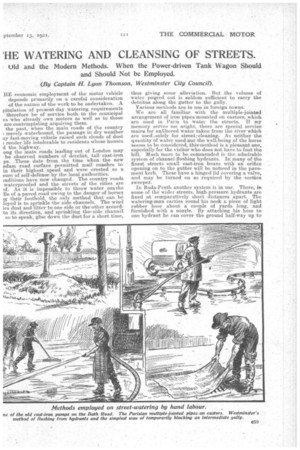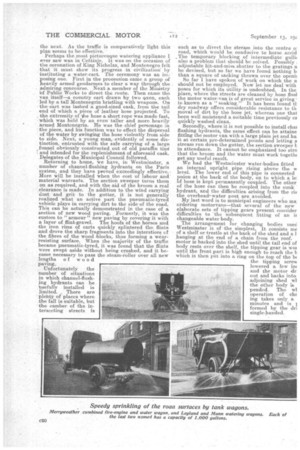HE WATERING AND CLEANSING OF STREETS.
Page 15

Page 16

If you've noticed an error in this article please click here to report it so we can fix it.
Old and the Modern Methods. When the Power-driven Tank Wagon Should and Should Not be Employed.
(By Captain H. Lyon Thomson, Westminster City Council).
HE economic employment of the motor vehicle depends primarily on a eareful consideration of the nature of the work to be undertaken. A pitulation of present-day .watering requirements therefore be of service both to the municipal es who already own motors as well as to those are contemplating acquiring them. the past, when the main roads of the country merely waterbound, the passage in dry weather ay fast-moving vehicle raised such clouds of dust render life intolerable to residents whose houses d the highway. ong the main roads leading out of London may be observed numbers of derelict, tall cast-iron ps. These date from the time when the new &dam road surface permitted mail •coaches to in their highest speed and were erected as a sure of self-defence by the local authorities.
mdition,s have now changed. The 'country roads waterproofed and the streets of the cities are ;d. As it is impossible to throw water on the Be of a paved road owing to the danger of horses ig their foothold, the only method that can be loyed is to sprinkle the side channels. The wind ies dust and litter to one side or the-other accordto its direction, and sprinkling the, side channel so to speak, glue down the dust for a short time,
thus giving some alleviation. But the volume of water poured out is seldom sufficient to carry the detritus along the gutter to the gully.
Various methods are in use in foreign towns.
We are all familiar with the multiple-jointed arrangement of iron pipes.mounted on castors, which are used in Paris to water the streets. If my memory serves me aright, there are special service mains for unfiltered water taken from the river which are used rsolely for street:cleaning. As neither the quantity of water used nor the well-being of the horse seems to be considered, this method is a pleasant one, especially for the visitor who does not have to foot the bill. Much more to be. commended is the admirable system of channel-flushing hydrants. In many of the finest streets small cast-iron boxes with an orifice opening on to the gutter will be noticed in the pavement kerb. These have a hinged lid covering a valve, and may be turned on as required by the -section sweeper.
In Buda-Pesth another system is in use. There, in some of the wider streets, high-pressure hydrants are fixed at comparatively short distances apart. The watering-man carries round.'his neck a piece of light rubber hose about a couple of yards long, and farnished with a nozzle. By attaching his hose to one hydrant he can -cover the ground half-way up to
the next. As the traffic is comparatively light this plan seems to be effective. Perhaps the most picturesque watering appliance I ever saw was in Cettinje. it was on the occasion of the coronation of King Nicholas, and Montenegro felt that it must show its progress in civilization by instituting a water-cart, The ceremony was an imposing one. First in the procession came a group of heavily armed gendarmes to clear a way through the . admiring concourse. Next a member of the Ministry Of Public Works to direct the route. Then came the van itself—a country cart drawn by two xen, each led by a tall Montenegrin bristling with weapons. On the cart was lashed a good-sized cask, from the tail end of which a piece of leather hose projected. To the extremity of lhe hose a short rope was made fast, which was held by an even taller and more heavily armed Montenegrin. He was the chief personage in • ;the piece, and his function was to effect the dispersal of the water by swinging the hose violently from side to side. Next, a young man, .evidently of some distinction, entrusted with the safe carrying of a large . funnel obviously constructed out of old paraffin tine k and intended for the replenishment of aforesaid cask. Delegates of the Municipal Council followed. Returning to home, we have, in Westminster, a number of channel-flushing hydrants on the Paris system, and they have proved exceedingly effective.More will be installed when the cost of labour and material warrants. The section sweeper turns theme on as required, and with the aid of the broom a real clearance is made. In addition to the wind carrying dust and grit to the gutter, it is not generally realized what an active part the pneumatic-tyred vehicle plays in carrying dirt to the side of the road. This can be actually demonstrated in the ease of a. section of new wood paving. Formerly, it was the custom to "armour " new paving by covering it with a layer of flint-gravel. The hoofs of the horses and the iron rims of carts quickly splintered the flints and drove the sharp fragments into the interstices of the fibres of the wood blocks, thus forming a wearresisting surface. When the majority of the traffic became pneumatic-tyred, it was found that the flints were swept aside without being crushed, and it became necessary to pass the steam-roller over all new lengths of wood paving.
. Unfortunately the number of situations in which channel-flush ing hydrants can be Usefully installed is limited. There are ' plenty of places where the fall is suitable, but the camber of the intersecting streets is such as to divert the stream into the centre ol road, which would be conducive to horse a.ccid The temporary blocking of intermediate ullii also a problem that should be solved. Possibly ; adjustable hit-and-miss_ shutter to the gratings n be devised, but so far w.e have found nothing b than. a square of sacking thrown over the. openii So far I have spoken of work on which the should not be employed. Now let me deal with poses for which its utility is undoubted. In the place, where the streets are cleaned by hose Ilusl the motor water-van is of great service in giving isknown as a "soaking." It has been found ti dry roadway offers considerable resistance to th moval of dirt by the hose jet, whereas one that been well moistened a suitable time previously ca quickly washed clean. Secondly, where it is not possible to install chai flushing hydrants, the same effect can be attaine fitting the motor van with a large plain jet and ha it at certain pre-determined points and letting a stream run down the gutter, the section sweeper h in attendance. It cannot be emphasized too stro that the broom and the water must work togeth( get any useful result.
We had the 'Westminster water-bodies fitted an internal upright pipe rising above, the w level. The lower end of this pipe is connected union at the back of the body, on to which a le: Of hose is kept permanently coupled. The other of the hose can then be coupled into the sunk hydrant, and the difficulties arising from the ris the overhead-water post are avoided.
My last word is to municipal engineers who ma, ordering rnotorvans—that several of the new elaborate sets of tipping gears present consider difficulties to the subsequent fitting of an in changeable water.body. The arrangement for changing bodies used Westminster is of the simplest. It consists me of a shelf or trestle at the back of the shed and a }hanging at the end of a chain from the roof. motor is backed into the shed until the tail end of body rests over the shelf, the tipping gear is wca until the front part is high enough to reach the h which is then put into a ring on the top of the b( the tipping screw lowered a few in( and the motor dr out and backs into adjoining shed wl the other body is, pended. The wl operation of che ing takes only a minutes and is I formed by the dri single-handed.
































